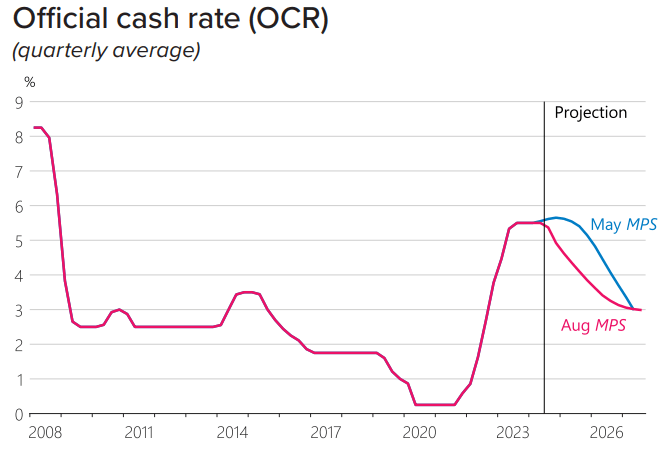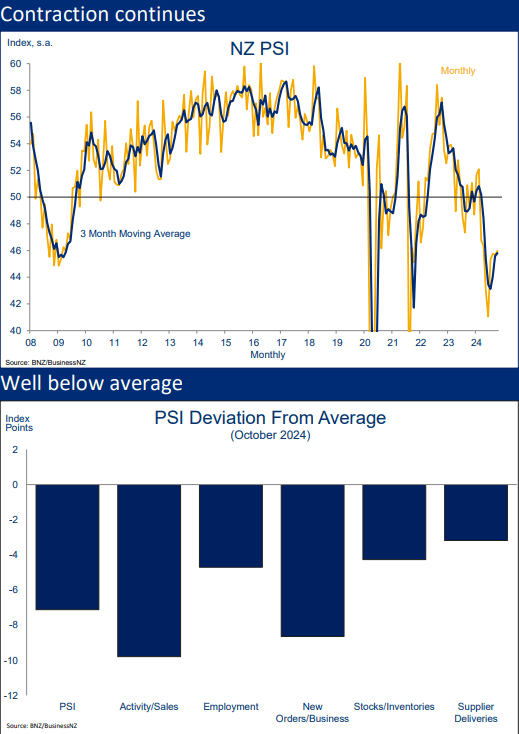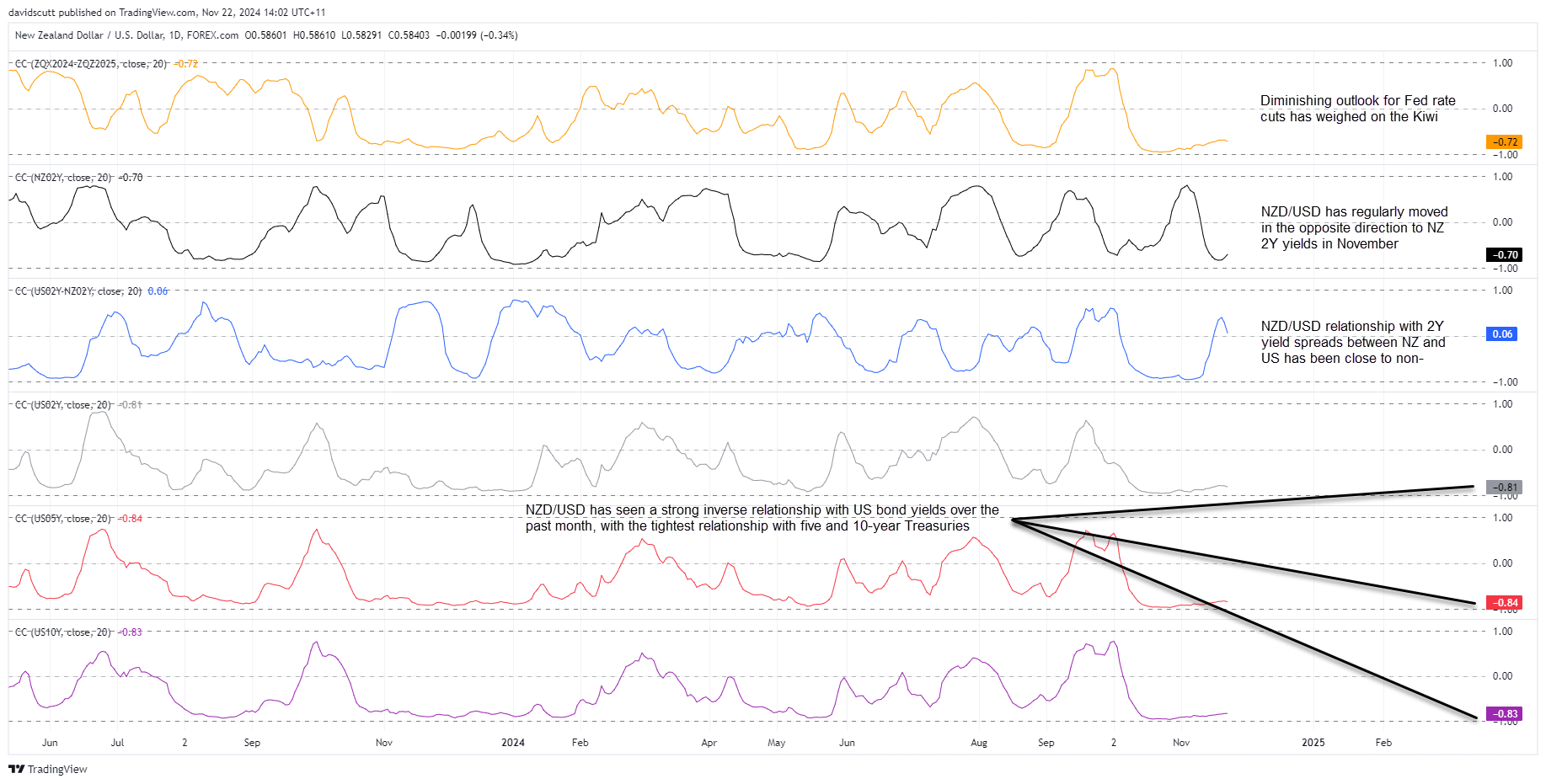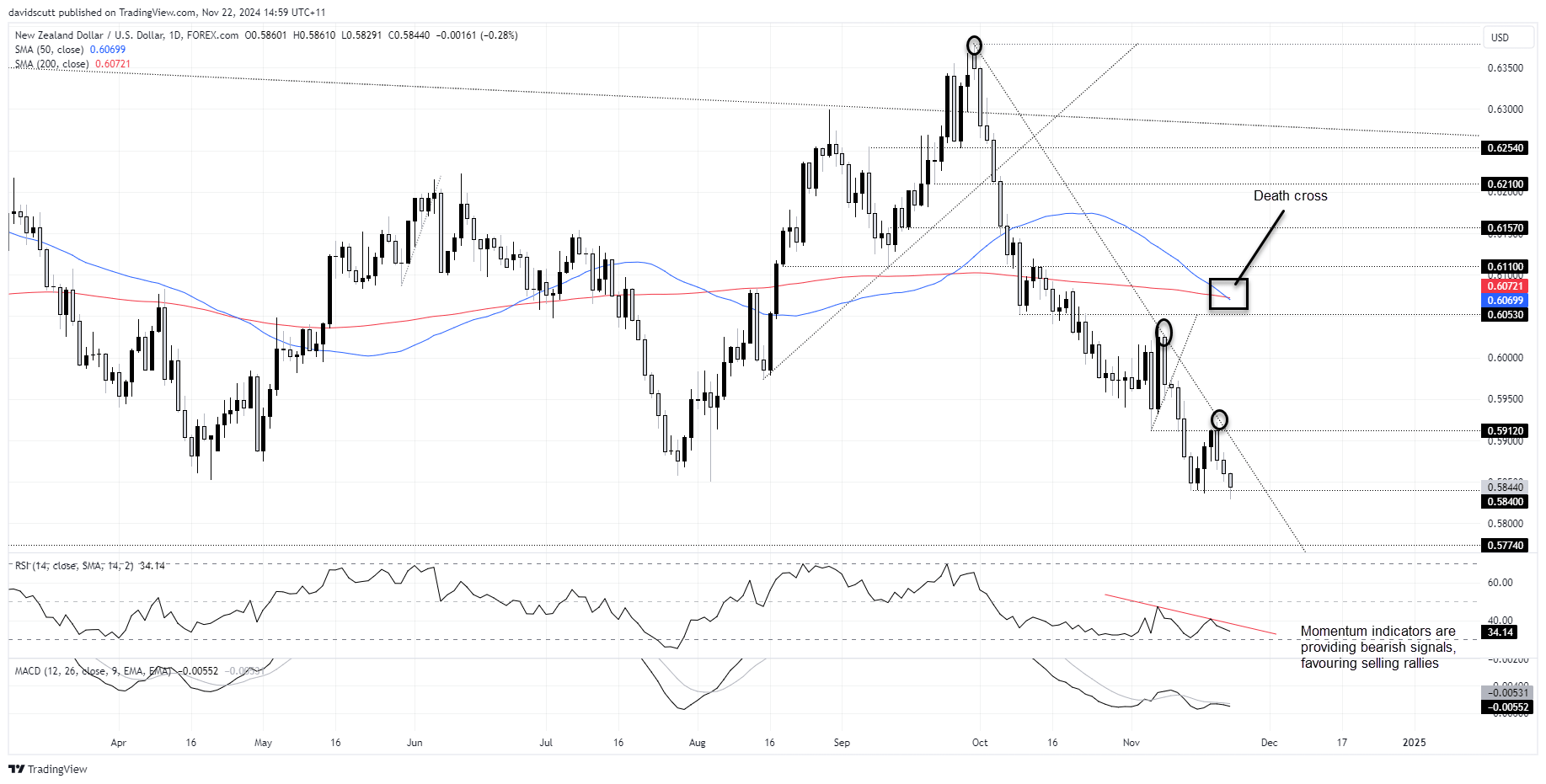- NZ exercise sluggish regardless of price cuts, tender surveys stay recessionary
- Markets, economists favour 50bps RBNZ minimize, 75bps appears to be like underpriced
- Money price 175bps above impartial, in response to RBNZ estimates
- Path of least remorse could also be to front-load cuts with 84-day break between conferences
- NZD/USD pushed by US charges, not home outlook
RBNZ November Preview
New Zealand’s financial exercise reveals little signal of restoration regardless of considerably decrease rates of interest, with many sentiment surveys nonetheless languishing in recessionary territory. For the Reserve Financial institution of New Zealand (RBNZ), this underscores the pressing want for a lot much less restrictive financial coverage.
With inflation expectations anchored across the midpoint of its 1–3% goal vary and with projections for an additional 175 foundation factors of price cuts this cycle, the board could also be tempted to chop by greater than 50 foundation factors with an 84-day hole between its November and February conferences. A really jumbo minimize subsequent Wednesday may very well be the trail of least remorse to stimulate the financial system over the summer season.
Go Large Earlier than Summer time Break?
The chance of a 75-basis-point minimize appears to be like underpriced forward of subsequent week’s RBNZ assembly, notably given the financial institution’s historical past of unusual markets below Governor Adrian “Shock and” Orr.
Heading into subsequent week’s price choice, a follow-up 50-point transfer is favored. Swap markets put the chance at just a little over 80%, with a good bigger 75 the rank outsider at lower than 20%. Economists are additionally backing a 50, with 27 of 30 surveyed by Reuters anticipating a discount to 4.25%.
Supply: Bloomberg
Path of Least Remorse
Warning round bigger cuts is comprehensible, particularly after the RBNZ moved from 25 to 50-basis-point reductions in September. It may amplify financial considerations additional. Nevertheless, the chance of hesitation when coverage is clearly too restrictive outweighs considerations over market perceptions.
Based mostly by itself forecasts, the RBNZ sees the impartial money price – the place its neither restrictive nor stimulatory for the inflation outlook – at 3%, which it expects to achieve by late subsequent 12 months or early 2026.
Supply: RBNZ
With the present price 175 foundation factors above impartial, why not front-load cuts to hurry up the transition? Even a 75-basis-point minimize subsequent week would go away coverage a full proportion level above the estimated impartial price, sustaining a level of restraint and mitigating the chance of inflation reigniting.
And let’s be sincere, New Zealand exercise knowledge suggests the specter of demand-driven inflation is near non-existent.
Assessing Inflation Reacceleration Risk
Citi’s Financial Shock Index stays unfavourable, exhibiting knowledge constantly underperforming expectations almost three months into the easing cycle. Whereas financial coverage operates with lags, the persistence of dire tender sentiment indicators is troubling.
Supply: Refinitiv
The BNZ Efficiency of Companies Index (PSI) launched this week hit 46.0 in October, indicating contracting exercise. It’s a stage corresponding to the depths of the International Monetary Disaster and has proven minimal enchancment for the reason that RBNZ started slicing charges. Main indicators like gross sales and new orders stay far beneath historic averages. The place does the inflation menace come from provided that outlook? Not the home financial system the RBNZ can affect.
Supply: BNZ
It makes the case for a daring transfer compelling, particularly given the lengthy hole between selections. A 75-point minimize appears to be like mispriced at lower than 20% chance, for my part, with risk-reward dynamics favoring positioning for such an consequence.
Home Charges Outlook Not Driving NZD/USD
Earlier than we have a look at the technical image for , it’s worthwhile addressing a priority usually heard at any time when massive coverage strikes are being contemplated: that decrease charges will result in traders fleeing the Kiwi.
The evaluation beneath disputes that, at the least based mostly on what’s been occurring just lately. Whereas there’s little doubt a 75-point transfer would seemingly result in kneejerk shunt decrease for NZD/USD, past the short-term, it’s the US bond curve you ought to be curious about.
Supply: Buying and selling View
Over the previous month, NZD/USD has had the strongest relationship with US bond yields between and . The Kiwi has usually moved in the wrong way to US yields over this era. The inverse relationship has additionally been sturdy with yields, albeit marginally weaker.
Tellingly, the correlation with New Zealand two-year yields is reasonably unfavourable, suggesting the Kiwi has tended to push larger when home charges have fallen. Inform me once more that decrease charges will result in a Kiwi bloodbath?
Simply to bolster the purpose, the connection between US and New Zealand two-year yield spreads has basically been zero in November. It’s US charges driving the hen.
NZD/USD Technical Image
Supply: Buying and selling View
NZD/USD appears to be like heavy on the charts, hitting recent 2024 lows earlier in immediately’s session. With the value in a downtrend, mirroring momentum indicators equivalent to RSI (14) and MACD, it’s an apparent sell-on-rallies play. Symbolically, the 50-day transferring common has crossed its 200-day equal from above, delivering what’s referred to as a “dying cross”. I don’t are likely to put a lot weight on such occurrences, but it surely’s most likely applicable.
Close to-term, shopping for has been evident beneath .5840, making that the primary draw back stage of word. Past, .5774 and .5600 must be on the radar, coinciding with market bottoms of prior years. If the Kiwi had been to interrupt the downtrend its buying and selling in, which seems unlikely near-term, .5912 and .6053 are ranges of potential resistance.